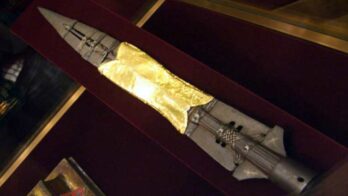Holy Grail was believed to possess miraculous powers and was said to have been crafted from a single precious stone.
Throughout medieval literature, the Holy Grail takes on many forms, including a relic of Christ’s Precious Blood, a spear, a sword, a cup, a pot, a silver dish, a cauldron of abundance, a stone from heaven, a vessel, a fish, a white lance stained with blood, a secret gospel, manna from heaven, a dove carrying a host for the Holy Sacrament in its beak, a blinding light, a beheaded head, or a table.
Etymology
The word “grail” is derived from the Latin word “cratalis,” which means “a mixing vessel.”
Over time, the word evolved into “garalis” and eventually “greal” in medieval French, before settling into “grail” in English.
Another possible origin of the word comes from a Christian monk named Helinandus, who wrote about a hermit who had a vision of the cup used by Jesus at the Last Supper.
The hermit wrote a book in Latin and called the vessel “gradale,” which in French means a “deep and wide vessel in which food is placed.”
This word is similar to “greal” (“pleasing”), which was the term used to designate the vessel in French legends and became “grail” in English.
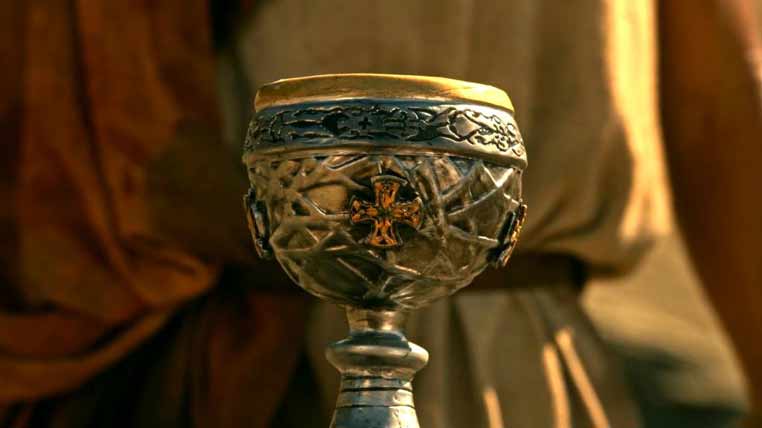
The Holy Grail in Medieval Literature
The Holy Grail in medieval literature is the successor to two pre-Christian Celtic talismans: the cauldron of Dagda and the cup of the sovereign.
The Grail often appears in these legends as a deep vessel carried by a virgin and has the power to offer each knight of the Round Table their favorite meat dish.
In addition to the gift of life, the Grail is said to offer spiritual illumination and invincible strength.
The Grail has been interpreted in various ways, depending on the commentator’s level of reality.
According to Albert Beguin, the Grail represents the dead Christ for men, the pot used at the Last Supper (divine grace granted by Christ to his disciples), and the liturgical chalice containing the true blood of the Savior.
The table on which the pot is placed is said to represent the stone of the Holy Sepulcher, the table of the twelve apostles, and finally, the altar on which the daily sacrifice is made.
The Crucifixion, the Last Supper, and the Eucharist are inseparable. The Grail ceremony consists of their revelation, conferring on communion the knowledge of the person of Christ and participation in his redeeming sacrifice.
King Arthur and the Holy Grail
Legend has it that Joseph of Arimathea, a biblical figure, acquired the Holy Grail cup after the crucifixion of Jesus.
After being imprisoned for expressing his belief that Jesus was the Messiah, he traveled west to the British Isles, taking the Grail with him, and leaving it to his descendants upon his death.
According to believers, the Grail had magical powers, providing them with food and safety through the grace of God.
Over the generations, due to a lack of faith and Christian humility among its keepers, the Grail’s powers were lost, and the precious relic was forgotten.
Despite this, the legend of the Grail was perpetuated in literature, mainly through the stories of the Knights of the Round Table, who served the legendary King Arthur of Britain.
The quest for the Holy Grail was a combination of supernatural adventures, idylls, Christian myths, and the wisdom of the ancient Celts, who occupied a large part of Western Europe until the Roman conquest.
King Arthur, the great sovereign of ancient Britain, was likely inspired by a real character who lived around 500 AD or even earlier.
According to Celtic folklore, Arthur helped to stop the invasions of the Angles and Saxons, Germanic tribes that later conquered Britain in the 5th century.
Arthur emerged as a historical figure around 1100 when Geoffrey of Monmouth (1100-1154) wrote his book, “The History of the Kings of Britain,” detailing his heroic reign.
Much of Geoffrey’s material was gathered from stories and lacks historical accuracy.
However, his work was extremely popular, being translated from Latin into French by a poet named Wace in 1155 and into Medieval English by the poet Layamon a few years later.
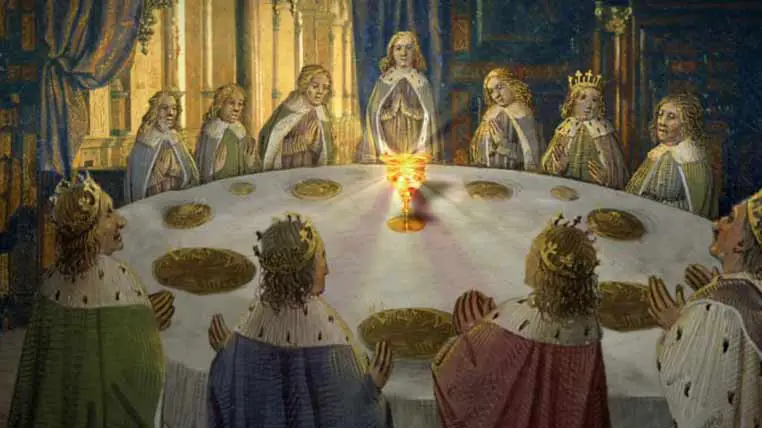
Between 1160 and 1180, the French poet Chretien de Troyes wrote five significant works about Arthur and his knights, all based on histories and legends of that time.
Chretien helped to introduce and popularize the Holy Grail legend, but he died before completing the full description of the mysterious and powerful artifact housed in the Castle of the Grail.
In Chretien’s version, Arthur’s knights, Gawain and Percival, traveled to the castle where the Holy Grail was located.
Chretien’s unfinished manuscript was later continued by other authors.
Around 1200, the German poet Wolfram von Eschenbach (1170-1220) wrote a legend about a young knight, Parzival, who set out to become a King Arthur court member.
Along the way, Parzival witnessed a procession venerating a bright object, the Holy Grail, and a lance, the one with which Jesus was pierced on the cross.
In the presence of the Grail, King Fisherman lost his speech and was paralyzed, and Parzival failed to learn more about the mysterious procession and the objects he saw.
He could have used the Holy Grail’s magical powers to heal the infirm monarch, but he missed the chance due to his lack of knowledge. Only much later, after many adventures, did Parzival find out the true nature of the Grail.
After he understood the relic’s true power, Parzival returned to the castle of King Fisherman, healed him, and restored the fertility of his lands, which had become barren when the monarch was afflicted with infirmity.
The later stories surrounding the Holy Grail exhibit Christian influences, notably Sir Thomas Malory’s “Morte d’Arthur” (eng. “The Death of Arthur”), written in 1470.
The legendary object becomes the sought-after prize by the Knights of the Round Table in the most famous collection of Arthurian stories.
Sir Galahad, who is completely sinless, eventually finds the Holy Grail. Accompanied by two other virtuous knights, Sir Bors and Sir Percival (Parzeval), only Sir Galahad, a symbol of Christian piety, obtains the cup.
To some extent, the Holy Grail legends could have been inspired by Celtic folklore. It is possible that the myth developed from references to magical cauldrons that appear in numerous Celtic myths and practices.
Weston (1920) finds similarities between Celtic myths and the legends of the Holy Grail.
Some Celtic fertility rituals, for example, were intended to ensure the health and vitality of the community leader. The physical well-being of the land was tied to that of the sovereign.
The sterility and impotence of the Fisher King, in a legend such as Parzeval’s, could thus indicate the king committing a sin, followed by his physical infirmity, which also affected his lands.
Celtic legends refer to the Fisher King, the ruler of a barren land, known as the “deserted realm” or the “wasteland.”
Loomis (1963) and Owen (1968) suggest that Celtic sources influenced the Grail legend.
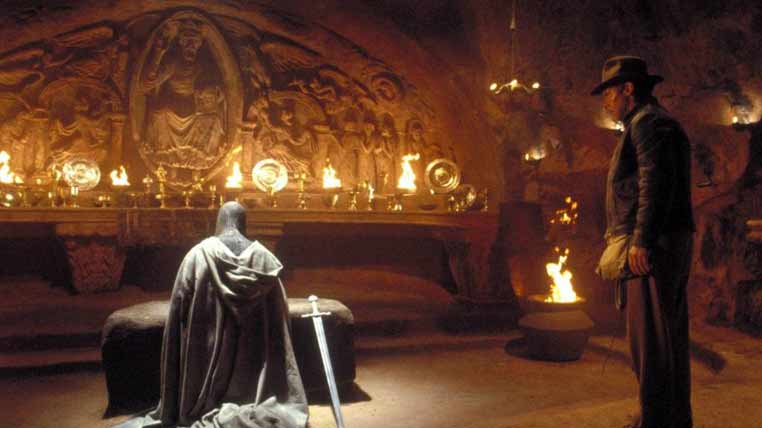
The Holy Grail in Modern Culture
The legendary Holy Grail remains as popular in modern culture as it was during the period from 1150-1250. At that time, stories about it were highly esteemed at the courts of France, England, and Germany.
Today, books and films about the quest for the Holy Grail (including Monty Python and the Holy Grail, 1975; Excalibur, 1981; and Indiana Jones and the Last Crusade, 1989) still fascinate millions of people worldwide.
The Holy Grail persists as a symbol of higher spirituality, whether of supernatural or divine origin. It represents a longing for a sublime reality to which people aspire.
However, the quest for the Holy Grail demands conditions of inner life rarely encountered.
External activities are contrary to the necessary contemplation and remove the desire. It is in immediate proximity, but the eyes do not see it.
This is the drama of blindness in the face of spiritual reality. All the more intense, the more sincerely we believe we are searching for it.
The quest for the inaccessible Holy Grail symbolizes, on the mystical level, the essential adventure of spirituality and the need for interiorization, the only one capable of opening the gates of the celestial Jerusalem, where the divine chalice shines.
Human perfection is not conquered with lance blows, like a material treasure, but through a radical transformation of the spirit and heart.
We must go beyond Lancelot or Parsifal to reach the transparency of the Grail, the living image of Jesus Christ.
Where Is the Holy Grail?
The mystery surrounding the Holy Grail has captured the imaginations of many throughout the years, as its potential locations remain shrouded in myth and legend.
Countless researchers have dedicated their lives to finding the great Christian relic, but to this day, the question of its true whereabouts remains unsolved.
One popular theory suggests that the Holy Grail was buried in the depths of the Glastonbury Tor, and that it is the source of a spring known today as the Chalice Well.
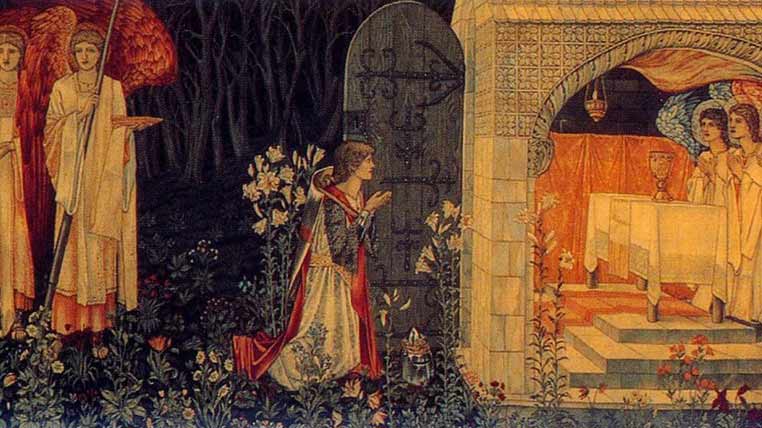
In his book, “Lost Histories,” Joel Levy proposes that the reddish color of the water is because it bathes the chalice, mixing with the blood of Jesus.
However, geologists have explained that the high concentration of iron oxides in the rocks through which it passes gives the water its red hue.
Another possible location for the Holy Grail is the Cathedral of Valencia in Spain.
A small cup of red agate decorated with semi-precious stones and white pearls, known as the Santo Caliz or “Holy Chalice,” is on display there.
However, laboratory analysis has indisputably shown that the artifact exhibited in Valencia dates back to around 1134.
Yet, the Spanish people refuse to acknowledge the scientific evidence presented and instead claim to have a so-called “certificate of authenticity,” which states that the chalice was brought to Rome by Saint Peter himself before being transported to Spain to protect it from destruction during the persecution of the Christians by Emperor Valerian in 258 AD.
Corbenic Castle in Britain is also considered a potential location for the Holy Grail.
Built on the site of an ancient Iron Age structure, the medieval castle is said to have held the mysterious chalice.
According to some accounts, the Grail was taken to Wales, where it was entrusted to Lord Nanteos Manor, the region’s ruler at that time.
Unlike the chalice exhibited in Valencia, Nanteos’ cup is a small wooden bowl supposedly carved from olive wood from Palestine.
Pilgrims have chipped the bowl in a few places, after taking small pieces of the cup, which is believed to have the power to heal.
In fact, Joel Levy’s investigation revealed several local stories of people who were cured of incurable illnesses after drinking water from that wooden bowl.
Although many references to the Holy Grail can be found in British legends, and chalices claiming to be the legendary cup can be found in various places around the world, conclusive evidence has yet to be seen to prove its existence.
Even if an object were to be discovered that matched the biblical description of the Holy Grail, researchers and archaeologists would likely never be able to prove its origin.
In the end, the mystery of the Holy Grail remains just that – a mystery.
At Ancient Theory we only use trusted sources to document our articles. Such relevant sources include authentic documents, newspaper and magazine articles, established authors, or reputable websites.
- Henrietta Bernstein - The Ark of the Covenant, the Holy Grail. DeVorss Publications, Marina del Rey, California, 1998.
- Norma Goodrich - The Holy Grail. Harper-Collins Publishers, New York, 1998.
- Jessie Weston - From Ritual to Romance. Dover Publications, Mineola, New York, 1997.
- Holy Grail - wikipedia.org. [Source]
- Holy Grail - history.com. [Source]


